Related Research Articles

The Algonquin Hotel is a hotel at 59 West 44th Street in Midtown Manhattan, New York City, United States. The 181-room hotel, opened in 1902, was designed by architect Goldwin Starrett for the Puritan Realty Company. The hotel has hosted numerous literary and theatrical notables throughout its history, including members of the Algonquin Round Table club during the early 20th century. Its first owner-manager, Frank Case, established many of the hotel's traditions, including an official hotel cat as well as discounts for struggling authors. The hotel is a New York City designated landmark.
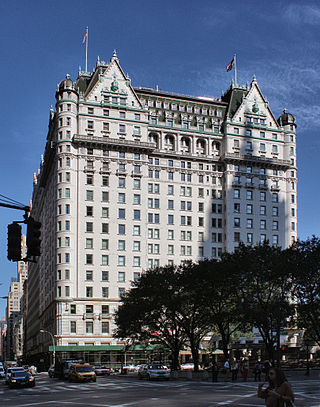
The Plaza Hotel is a luxury hotel and condominium apartment building in Midtown Manhattan in New York City. It is located on the western side of Grand Army Plaza, after which it is named, just west of Fifth Avenue, and is between 58th Street and Central Park South, at the southeastern corner of Central Park. Its primary address is 768 Fifth Avenue, though the residential entrance is One Central Park South.

The New York Biltmore Hotel was a luxury hotel at 335 Madison Avenue in Midtown Manhattan, New York City. The hotel was developed by the New York Central Railroad and the New York, New Haven and Hartford Railroad and operated from 1913 to 1981. It was one of several large hotels developed around Grand Central Terminal as part of Terminal City. The Biltmore was designed in the Italian Renaissance Revival style by Warren and Wetmore, one of the firms involved in designing Grand Central. Although the hotel's steel frame still exists, the hotel itself was almost entirely demolished and replaced by an office building in the early 1980s.

The Yaqui River is a river in the state of Sonora in northwestern Mexico. It was formerly known as the Rio del Norte. Being the largest river system in the state of Sonora, the Yaqui river is used for irrigation, especially in the Valle del Yaqui.

John Hays Hammond was an American mining engineer, diplomat, and philanthropist. He amassed a sizable fortune before the age of 40. An early advocate of deep mining, Hammond was given complete charge of Cecil Rhodes' mines in South Africa and made each undertaking a financial success. He was a main force planning and executing the Jameson Raid in 1895. It was a fiasco and Hammond, along with the other leaders of the Johannesburg Reform Committee, was arrested and sentenced to death. The Reform Committee leaders were released after paying large fines, but like many of the leaders, Hammond escaped Africa for good. He returned to the United States, became a close friend of President William Howard Taft, and was appointed a special ambassador. At the same time, he continued to develop mines in Mexico and California and, in 1923, he made another fortune while drilling for oil with the Burnham Exploration Company.
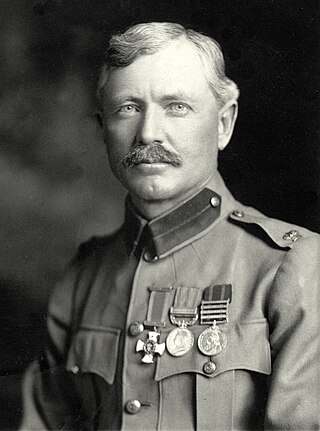
Frederick Russell Burnham DSO was an American scout and world-traveling adventurer. He is known for his service to the British South Africa Company and to the British Army in colonial Africa, and for teaching woodcraft to Robert Baden-Powell in Rhodesia. He helped inspire the founding of the international Scouting Movement.

The Ansonia is a condominium building at 2109 Broadway, between 73rd and 74th Streets, on the Upper West Side of Manhattan in New York City. The 17-story structure was designed by French architect Paul Emile Duboy in the Beaux-Arts style. It was built between 1899 and 1903 as a residential hotel by William Earle Dodge Stokes, who named it after his grandfather, the industrialist Anson Greene Phelps. Over the years, the Ansonia has housed many conductors, opera singers, baseball players, and other famous and wealthy people. The Ansonia is a New York City designated landmark and is listed on the National Register of Historic Places.
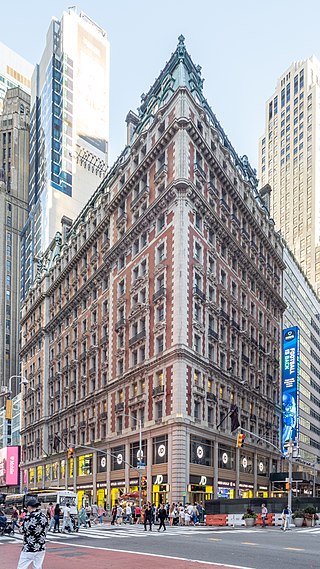
The Knickerbocker Hotel is a hotel at Times Square, on the southeastern corner of Broadway and 42nd Street, in the Midtown Manhattan neighborhood of New York City. Built by John Jacob Astor IV, the hostelry was designed in 1901 and opened in 1906. Its location near the Theater District around Times Square was intended to attract not only residential guests but also theater visitors.

The Roosevelt Hotel is a former hotel at 45 East 45th Street in the Midtown Manhattan neighborhood of New York City. Named in honor of U.S. president Theodore Roosevelt, the hotel was developed by the New York Central Railroad and the New York, New Haven and Hartford Railroad and opened in 1924. The 19-story structure was designed by George B. Post & Son with an Italian Renaissance Revival-style facade, as well as interiors that resembled historical American buildings. The Roosevelt Hotel is one of several large hotels developed around Grand Central Terminal as part of Terminal City.

The Royalton Hotel is a hotel at 44 West 44th Street in Midtown Manhattan, New York City, United States. The hotel, opened in 1898, was designed by architecture firm Rossiter & Wright and developed by civil engineer Edward G. Bailey. The 13-story building is made of brick, stone, terracotta, and iron. The hotel's lobby, which connects 43rd and 44th Streets, contains a bar and restaurant. The upper stories originally featured 90 apartments, but these were replaced with 205 guestrooms when Philippe Starck and Gruzen Samton Steinglass Architects converted the Royalton to a boutique hotel in the 1980s.
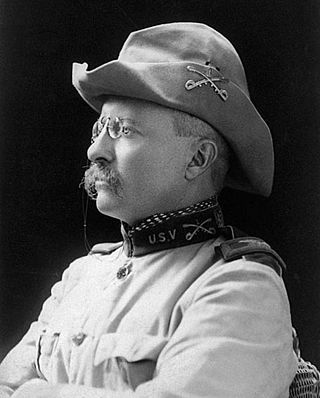
Roosevelt's World War I volunteers was a proposed military volunteer formation of Americans to fight in France for the Allies.

The Park Avenue Viaduct, also known as the Pershing Square Viaduct, is a roadway in Manhattan in New York City. It carries vehicular traffic on Park Avenue from 40th to 46th Streets around Grand Central Terminal and the MetLife Building, then through the Helmsley Building. All three buildings lie across the north–south line of the avenue. The viaduct itself is composed of two sections: a steel viaduct with two roadways from 40th to 42nd Streets, as well as a pair of roadways between 42nd and 46th Streets. The section from 40th to 42nd Streets was designated a New York City landmark in 1980 and was listed on the National Register of Historic Places in 1983. The street-level service roads of Park Avenue, which flank the viaduct between 40th and 42nd Streets, are called Pershing Square.

The InterContinental New York Barclay Hotel is a hotel at 111 East 48th Street, on Lexington Avenue between 48th and 49th Streets, in the Midtown Manhattan neighborhood of New York City. The 14-story hotel, operated by IHG Hotels & Resorts, was designed by Cross and Cross in the Colonial style and contains 702 rooms. The Barclay was one of several large hotels developed around Grand Central Terminal as part of Terminal City.

Row NYC Hotel is a hotel at 700 Eighth Avenue, between 44th and 45th Streets, in the Midtown Manhattan neighborhood of New York City. The hotel is 27 stories tall with 1,331 rooms. Designed by Schwartz & Gross, with Herbert J. Krapp as consulting architect, it was developed by brothers Henry and Irwin Chanin and opened on February 1, 1928, as the Hotel Lincoln. The hotel largely retains its original brick-and-terracotta facade. The interior spaces, which originally included a lobby and various restaurants on the first three stories, have been redesigned substantially over the years.

The Peninsula New York is a historic luxury hotel at the corner of Fifth Avenue and 55th Street in the Midtown Manhattan neighborhood of New York City. Built in 1905 as the Gotham Hotel, the structure was designed by Hiss and Weekes in the neoclassical style. The hotel is part of the Hong Kong–based Peninsula Hotels group, which is owned by Hongkong and Shanghai Hotels (HSH). The structure is 23 stories high and contains 241 rooms as of 2022.

The Millennium Times Square New York is a hotel at 133 and 145 West 44th Street, between Times Square and Sixth Avenue, in the Theater District of Midtown Manhattan in New York City. Operated by Millennium & Copthorne Hotels, the hotel has 750 guest units, as well as a conference center with 33 conference rooms. The hotel incorporates a Broadway theater called the Hudson Theatre into its base.

Herbert Mason Sears (1867-1942) was a noted yachtsman and businessman in Boston, Massachusetts. He was awarded the Croix de Guerre for his contributions during World War I.

The Penn Club of New York is an American private, social club located on Clubhouse Row in the Midtown Manhattan neighborhood of New York City. The club's 14-story building, which is a designated landmark, is located at 30 West 44th Street and initially was occupied by The Yale Club of New York City. For numerous consecutive terms, The Penn Club won the Platinum Club of America award, placing it in the top 3% among 6,000 clubs in the U.S. for perceived excellence, and ranked 14-best city club in the U.S., and second-best city club in New York City.
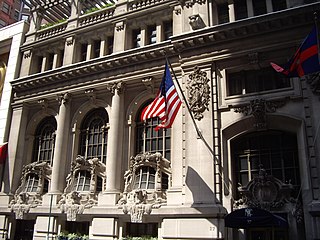
The New York Yacht Club Building is a seven-story Beaux-Arts clubhouse at 37 West 44th Street in the Midtown Manhattan neighborhood of New York City. Opened in 1901, the building was designed by architect Whitney Warren of Warren and Wetmore as the sixth clubhouse of the New York Yacht Club (NYYC). The clubhouse is part of Clubhouse Row, a concentration of clubhouses on 44th Street between Fifth and Sixth Avenues. The building is a New York City designated landmark and is listed on the National Register of Historic Places as a National Historic Landmark.
References
- ↑ "A Rocky Mountain Club Incorporates". The New York Times. 1907-01-20. p. 9. ISSN 0362-4331 . Retrieved 2022-10-23.
- ↑ "The Wealthy Rocky Mountain Takes Quarters in Hotel Knickerbocker". The New York Times. 1907-11-01. p. 3. ISSN 0362-4331 . Retrieved 2022-10-23.
- ↑ "Western Men's New Home; Rocky Mountain Club Has Housewarming at 65 West 44th St". The New York Times. 1913-12-28. p. 3. ISSN 0362-4331 . Retrieved 2022-10-23.
- ↑ "Club in New York Pledges $500,000 to Belgian Relief; Fund for New Million-Dollar Home for Rocky Mountain Club Turned Over". The New York Times. 1917-01-30. p. 1. ISSN 0362-4331 . Retrieved 2022-10-23.
- ↑ "Enroll Westerners for Service in War; Movement to Register Men of That Region Begun at the Rocky Mountain Club". The New York Times. 1917-03-13. p. 11. ISSN 0362-4331 . Retrieved 2022-10-23.
- Salt Lake Telegram, November 9, 1907
- New York Times, January 19, 1907
- New York Times, March 4, 1928
- John Hays Hammond, Sr. Papers. Manuscripts and Archives, Yale University Library.
- Autobiography of John Hays Hammond, John Hays Hammond, Farrar & Rinehart, 565. ISBN 0-405-05913-2 (1935).